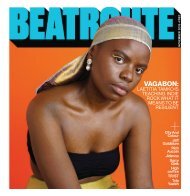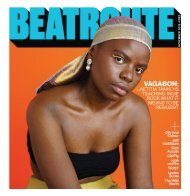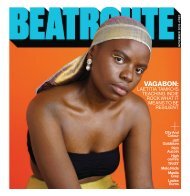BeatRoute Magazine [AB] print e-edition - [May 2018]
BeatRoute Magazine is a monthly arts and entertainment paper with a predominant focus on music – local, independent or otherwise. The paper started in June 2004 and continues to provide a healthy dose of perversity while exercising rock ‘n’ roll ethics.
BeatRoute Magazine is a monthly arts and entertainment paper with a predominant focus on music – local, independent or otherwise. The paper started in June 2004 and continues to provide a healthy dose of perversity while exercising rock ‘n’ roll ethics.
You also want an ePaper? Increase the reach of your titles
YUMPU automatically turns print PDFs into web optimized ePapers that Google loves.
Double down the depths of hell<br />
The Excorcist and The Devil and Father Amorth<br />
hat an excellent day for an exorcism”<br />
“W – the croaking words slither between<br />
cracked, lifeless lips caked with the noxious vile<br />
which proceeded them. Two entities are scarcely<br />
visible in a room devoid of light – an exorcist,<br />
and the shell of what was once a vivacious<br />
12-year-old girl named Regan MacNeil. Digging<br />
into the days proceeding this moment in cinematic<br />
history would strike a collection of images<br />
revealing a third, commanding entity which<br />
could only be described as terrifying. Regan,<br />
once a picturesque vision of a perfect daughter,<br />
suddenly transformed into a shocking display<br />
spitting unspeakable profanities and projectile<br />
vomiting impossible amounts of soupy bile, furthermore,<br />
morbidly engaging in masturbation<br />
with a crucifix resulting in bloodied lacerations.<br />
The Exorcist (1973) boasts not only a high rank<br />
in horror history books, but also longevity as it<br />
still shakes contemporary audiences in a way<br />
they surely have not felt before despite having<br />
traipsed through the obnoxious gore of the<br />
torture porn sub-genre that dominated the<br />
early 2000s.<br />
The Exorcist was not the first religious horror<br />
film by any means – after all, Mia Farrow birthed<br />
her little devil spawn only a handful of years<br />
earlier in Rosemary’s Baby (1968). Though not<br />
the first to tap into arguably the most haunting<br />
sub-genre of horror, it was the first nominated<br />
for an Academy Award. Given that cinema-goers<br />
were graced with a film that literally had<br />
paramedics called on site to treat viewers from<br />
fainting, I’d consider this a stunning feat for the<br />
under-appreciated genre, and viable proof that<br />
some of us genre fans actually like being scared.<br />
Look Ma, no strings attached! Linda Blair’s levitation scene in The Exorcist.<br />
16 | MAY <strong>2018</strong> • BEATROUTE<br />
BY BREANNA WHIPPLE<br />
But what made The Exorcist so damn scary?<br />
Extending beyond the obviously unsettling<br />
visuals dominating the 122 minute run-time, it<br />
tapped into an frightening area etched in reality.<br />
William Peter Blatty, author of both the novel<br />
predating the film and the screenplay, derived<br />
inspiration from an actual exorcism of an anonymous<br />
young boy from Maryland that occurred<br />
in 1949. From what is known, the boy underwent<br />
numerous exorcisms, and several elements<br />
between the fictitious tale of Regan MacNeil is<br />
linear with the boy upon comparison.<br />
Blatty’s tale is, however, just that – fictitious.<br />
Despite this, it‘s reported that 500,000 Italian<br />
people alone see an exorcist every year. Though<br />
mastering the craft of lavishly presenting the<br />
horrors of demonic possession on film, it would<br />
not be until <strong>May</strong> of 2016 that director William<br />
Friedkin would witness one in real life.<br />
His latest feature, The Devil and Father Amorth<br />
(<strong>2018</strong>), is an experience offering a glimpse<br />
into the non-fictitious side of a spiritual practice<br />
he brought to light 45 years ago. Praising the<br />
work of renowned exorcist Father Amorth,<br />
Friedkin witnesses a woman’s ninth exorcism. As<br />
if that were not enticing enough, the documentary<br />
also includes interviews with Friedkin<br />
himself, Blatty, multiple doctors, and a woman<br />
successfully exorcised by Father Amorth. Very<br />
thorough and gripping, The Devil and Father<br />
Amorth is a wonderful addition to the legacy of<br />
the world’s greatest horror film.<br />
Catch The Exorcist and The Devil and Father Amorth<br />
at The Globe Cinema on Fri., <strong>May</strong> 18.<br />
MIKE HOOVES<br />
local filmmaker strives for a naturalistic<br />
queer perspective<br />
Growing up, Calgarian artist Mike Hooves<br />
fed their fascination for animation by<br />
spending hours playing Mario Paint on their<br />
Super Nintendo. Now at 25, Hooves is an<br />
artist, animator, illustrator, and filmmaker<br />
whose work is playful, whimsical and gestural.<br />
“Not completely polished, either,” says<br />
Hooves, “I like it to be a little rough.”<br />
Creating art largely from a queer,<br />
feminine perspective, Hooves also pulls<br />
influence from nature, which they attribute<br />
to their upbringing. “My Dad actually lives<br />
and works in a provincial park, so when I<br />
was younger he took me on a lot of hikes,”<br />
says Hooves. “I still go on hikes, but doing<br />
that when I was younger shaped my art a<br />
lot more.”<br />
This past December, Hooves painted a<br />
winter mountain landscape on the +15<br />
windows in Bankers Hall for the Bud of<br />
Bud Artist Collectives Augmented Reality<br />
Art Show. “I like the mountain-scapes that<br />
are just beyond Calgary that you’re always<br />
seeing when you’re in the city,” expresses<br />
Hooves. “When you see them, there’s that<br />
lingering thought of ‘there’s freedom, it’s so<br />
close to us!’ But it’s outside of Calgary. That<br />
influences my work a lot – that wilderness.”<br />
Continuously building off their naturalistic,<br />
queer, feminine perspective, Hooves<br />
has been shifting their focus from drawing<br />
and design to filmmaking. “I like filmmakers<br />
who work with small budgets,” says Hooves.<br />
“It makes their work more honest in all<br />
aspects of their films.” Over the past year,<br />
they’ve filmed and premiered two of their<br />
own small budget short films; POLYMORH,<br />
which is about Hooves’ gender identity,<br />
BY HANNAH MANY GUNS<br />
and G.E.M., a collaborative documentary<br />
that focuses on Good Life Community<br />
Bike Shop’s weekly Gender Empowerment<br />
Mechanics (G.E.M.) program.<br />
“I actually made these two films at the<br />
same time,” informs Hooves. “I didn’t really<br />
know what I was doing. A day of filming<br />
for me was just trying to pool my experiences<br />
together with the other people who<br />
I had to help me on set, and figuring things<br />
out. I liked to make it so I was working in<br />
spaces where it didn’t feel like I had to rush,<br />
so there was no malice or anything, and<br />
everyone was kind so we’d figure things out<br />
together. It was very collaborative, it was<br />
all about shared knowledge. Nobody really<br />
knew what we were doing overall, but we all<br />
knew how to do little pieces.” For these two<br />
shorts, Hooves’ counts John Waters, <strong>May</strong>a<br />
Deren, and Norman McLaren as her inspirations,<br />
along with countless underground<br />
animations.<br />
Presently, Hooves is working on a project<br />
with Fairy Tales, Calgary’s Queer Film Festival.<br />
“They’re going into their 20th anniversary<br />
this year, so they’ve commissioned a<br />
short documentary about Calgary’s queer<br />
history,” says Hooves. “I’m on the project<br />
with my partner, and I’m helping mostly<br />
with animation and info-graphics, like animating<br />
a map that shows the locations of<br />
where all our old gay bars used to be.” The<br />
film, Outliers: Calgary’s Queer History, will<br />
premiere at the Plaza Theatre.<br />
For more info on Mike Hooves and their work,<br />
follow them on Instagram at @mikehooves.<br />
FILM


![BeatRoute Magazine [AB] print e-edition - [May 2018]](https://img.yumpu.com/60218021/16/500x640/beatroute-magazine-ab-print-e-edition-may-2018.jpg)















